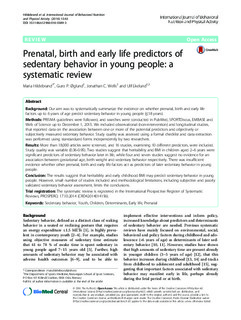| dc.contributor.author | Hildebrand, Maria | |
| dc.contributor.author | Øglund, Guro Pauck | |
| dc.contributor.author | Wells, Jonathan C. | |
| dc.contributor.author | Ekelund, Ulf | |
| dc.date.accessioned | 2017-01-17T14:42:43Z | |
| dc.date.available | 2017-01-17T14:42:43Z | |
| dc.date.issued | 2016-06-07 | |
| dc.identifier.citation | International Journal of Behavioral Nutrition and Physical Activity. 2016, 13, 1-12. doi: 10.1186/s12966-016-0389-3 | nb_NO |
| dc.identifier.uri | http://hdl.handle.net/11250/2427561 | |
| dc.description.abstract | Background: Our aim was to systematically summarize the evidence on whether prenatal, birth and early life factors up to 6 years of age predict sedentary behavior in young people (≤18 years). Methods: PRISMA guidelines were followed, and searches were conducted in PubMed, SPORTDiscus, EMBASE and Web of Science up to December 1, 2015. We included observational (non-intervention) and longitudinal studies, that reported data on the association between one or more of the potential predictors and objectively or subjectively measured sedentary behavior. Study quality was assessed using a formal checklist and data extraction was performed using standardized forms independently by two researchers. Results: More than 18,000 articles were screened, and 16 studies, examining 10 different predictors, were included. Study quality was variable (0.36-0.95). Two studies suggest that heritability and BMI in children aged 2–6 years were significant predictors of sedentary behavior later in life, while four and seven studies suggest no evidence for an association between gestational age, birth weight and sedentary behavior respectively. There was insufficient evidence whether other prenatal, birth and early life factors act as predictors of later sedentary behavior in young people. Conclusion: The results suggest that heritability and early childhood BMI may predict sedentary behavior in young people. However, small number of studies included and methodological limitations, including subjective and poorly validated sedentary behavior assessment, limits the conclusions. | nb_NO |
| dc.language.iso | eng | nb_NO |
| dc.publisher | BioMed Central | nb_NO |
| dc.subject | sedentary behavior | nb_NO |
| dc.subject | youth | nb_NO |
| dc.subject | children | nb_NO |
| dc.subject | determinants | nb_NO |
| dc.subject | early life | nb_NO |
| dc.subject | prenatal | nb_NO |
| dc.title | Prenatal, birth and early life predictors of sedentary behavior in young people: a systematic review | nb_NO |
| dc.type | Journal article | nb_NO |
| dc.type | Peer reviewed | nb_NO |
| dc.subject.nsi | VDP::Samfunnsvitenskap: 200::Samfunnsvitenskapelige idrettsfag: 330 | nb_NO |
| dc.subject.nsi | VDP::Medisinske Fag: 700::Idrettsmedisinske fag: 850 | nb_NO |
| dc.source.journal | International Journal of Behavioral Nutrition and Physical Activity | nb_NO |
| dc.identifier.doi | 10.1186/s12966-016-0389-3 | |
| dc.description.localcode | Seksjon for idrettsmedisinske fag / Department of Sports Medicine | nb_NO |
